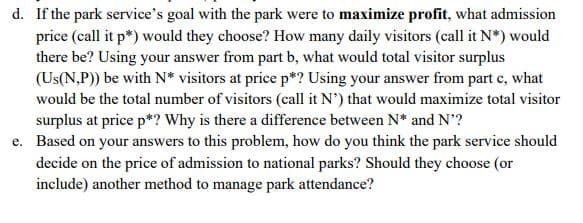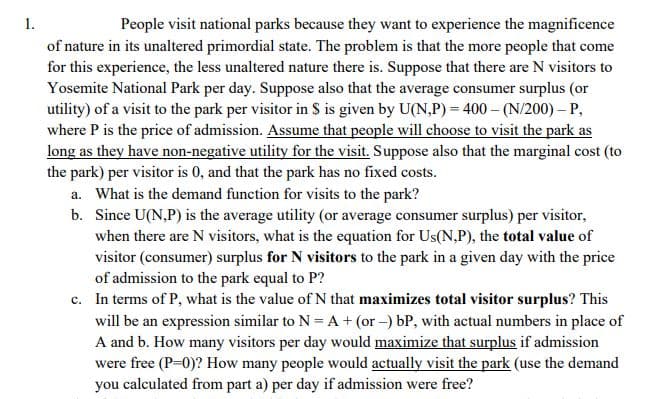d. If the park service's goal with the park were to maximize profit, what admission price (call it p*) would they choose? How many daily visitors (call it N*) would there be? Using your answer from part b, what would total visitor surplus (Us(N,P)) be with N* visitors at price p*? Using your answer from part c, what would be the total number of visitors (call it N') that would maximize total visitor surplus at price p*? Why is there a difference between N* and N'? e. Based on your answers to this problem, how do you think the park service should decide on the price of admission to national parks? Should they choose (or include) another method to manage park attendance?
d. If the park service's goal with the park were to maximize profit, what admission price (call it p*) would they choose? How many daily visitors (call it N*) would there be? Using your answer from part b, what would total visitor surplus (Us(N,P)) be with N* visitors at price p*? Using your answer from part c, what would be the total number of visitors (call it N') that would maximize total visitor surplus at price p*? Why is there a difference between N* and N'? e. Based on your answers to this problem, how do you think the park service should decide on the price of admission to national parks? Should they choose (or include) another method to manage park attendance?
Chapter6: Consumer Choice And Demand
Section: Chapter Questions
Problem 3.7P
Related questions
Question
part D and E

Transcribed Image Text:d. If the park service's goal with the park were to maximize profit, what admission
price (call it p*) would they choose? How many daily visitors (call it N*) would
there be? Using your answer from part b, what would total visitor surplus
(Us(N,P)) be with N* visitors at price p*? Using your answer from part c, what
would be the total number of visitors (call it N') that would maximize total visitor
surplus at price p*? Why is there a difference between N* and N'?
e. Based on your answers to this problem, how do you think the park service should
decide on the price of admission to national parks? Should they choose (or
include) another method to manage park attendance?

Transcribed Image Text:1.
People visit national parks because they want to experience the magnificence
of nature in its unaltered primordial state. The problem is that the more people that come
for this experience, the less unaltered nature there is. Suppose that there are N visitors to
Yosemite National Park per day. Suppose also that the average consumer surplus (or
utility) of a visit to the park per visitor in $ is given by U(N,P) = 400 – (N/200) - P,
where P is the price of admission. Assume that people will choose to visit the park as
long as they have non-negative utility for the visit. Suppose also that the marginal cost (to
the park) per visitor is 0, and that the park has no fixed costs.
a. What is the demand function for visits to the park?
b. Since U(N,P) is the average utility (or average consumer surplus) per visitor,
when there are N visitors, what is the equation for Us(N,P), the total value of
visitor (consumer) surplus for N visitors to the park in a given day with the price
of admission to the park equal to P?
c. In terms of P, what is the value of N that maximizes total visitor surplus? This
will be an expression similar to N = A + (or -) bP, with actual numbers in place of
A and b. How many visitors per day would maximize that surplus if admission
were free (P-0)? How many people would actually visit the park (use the demand
you calculated from part a) per day if admission were free?
Expert Solution
This question has been solved!
Explore an expertly crafted, step-by-step solution for a thorough understanding of key concepts.
This is a popular solution!
Trending now
This is a popular solution!
Step by step
Solved in 4 steps

Recommended textbooks for you



Principles of Microeconomics
Economics
ISBN:
9781305156050
Author:
N. Gregory Mankiw
Publisher:
Cengage Learning



Principles of Microeconomics
Economics
ISBN:
9781305156050
Author:
N. Gregory Mankiw
Publisher:
Cengage Learning